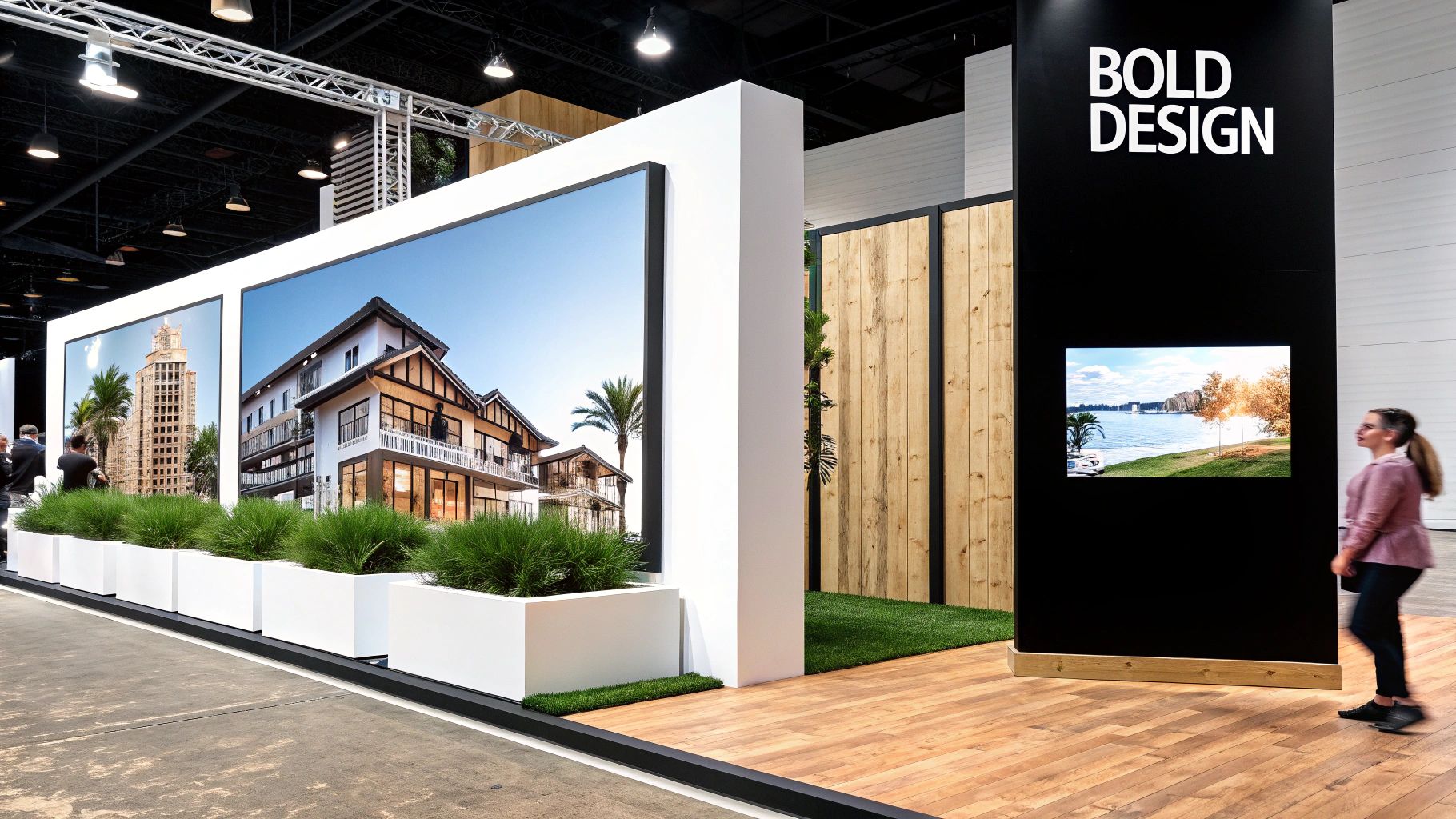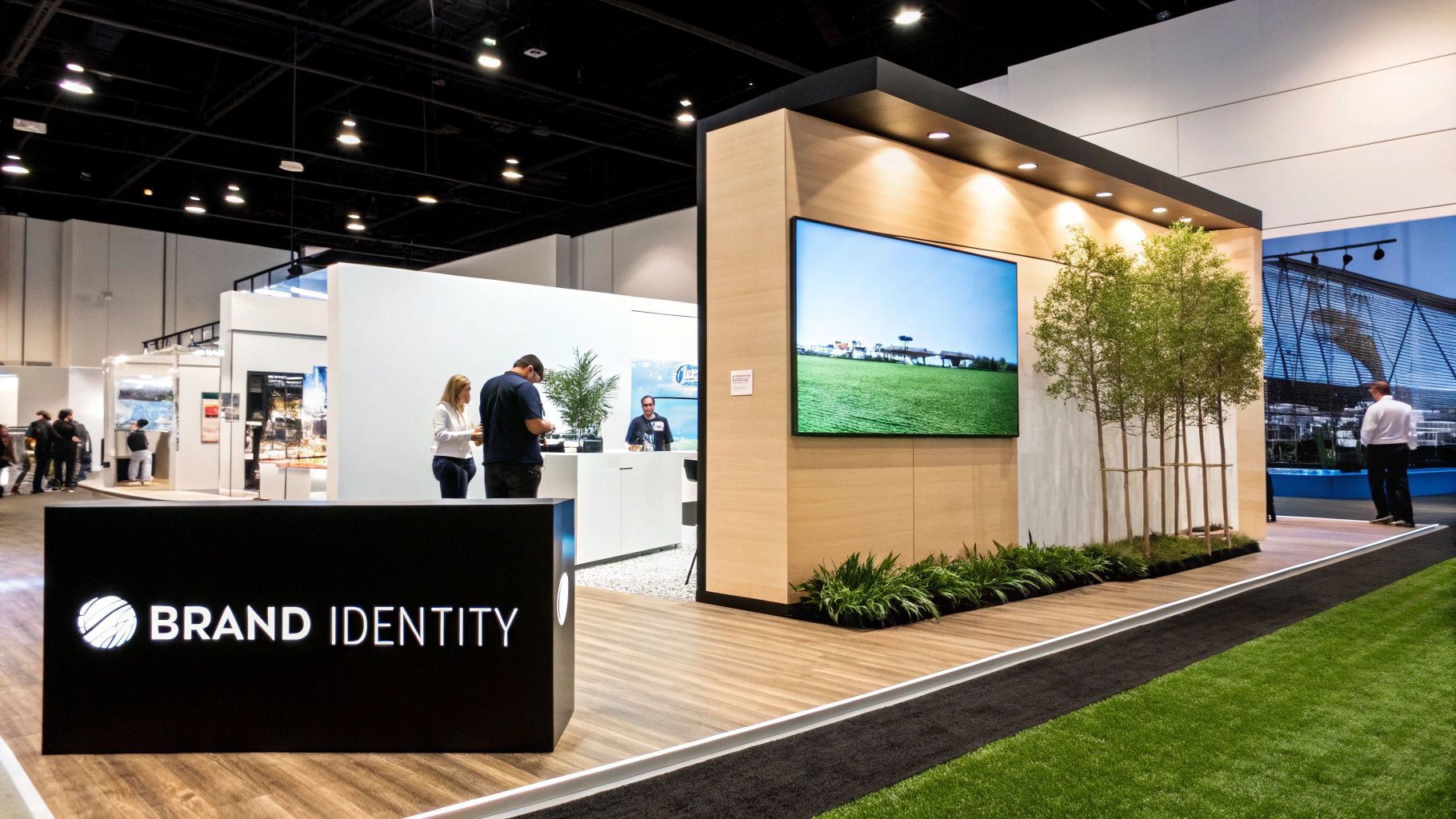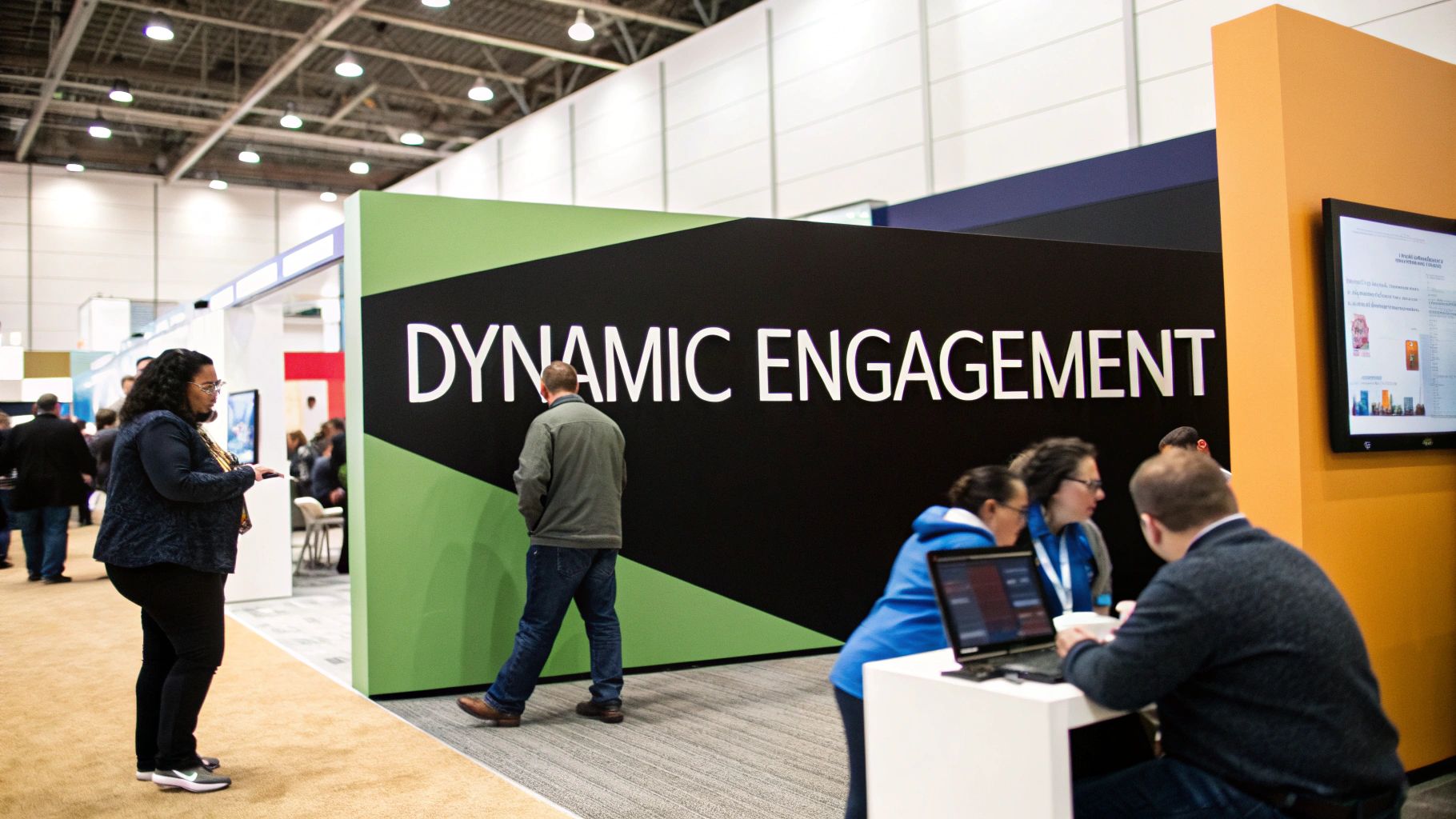Innovative Custom Trade Show Display Solutions
Why Custom Trade Show Displays Drive Measurable Brand Success
In today's competitive trade show environment, making a lasting impression is essential. While generic displays often blend into the background, custom trade show displays capture attention and create memorable experiences. But what makes them so effective at driving measurable brand success? The answer lies in their ability to transform visitor engagement and lead quality. By tailoring the display to your brand message and target audience, you create a more immersive experience.
Imagine a software company demonstrating its new product. A generic booth might consist of a simple banner and some brochures. A custom display, however, could feature interactive touchscreens for software demos, comfortable seating for personalized consultations, and strategic lighting to highlight key features. This type of engaging environment fosters deeper connections with potential clients.
The Power of Personalized Experiences
Custom displays effectively communicate brand values. They offer a unique opportunity to showcase your brand's personality and create a cohesive presentation, which is crucial for building brand recognition and a strong market presence. Think of your trade show booth as a physical extension of your brand. A custom display allows you to control every aspect of that representation, ensuring it aligns perfectly with your brand identity.
Furthermore, custom displays facilitate meaningful interactions with attendees. Instead of merely glancing at a standard booth, visitors are drawn to interactive experiences, personalized demonstrations, and opportunities for one-on-one engagement. This leads to higher-quality leads and improved conversion rates.
The Impact on Your Bottom Line
The emphasis on personalized experiences in the trade show landscape is reflected in the industry's growth. The global exhibitions market, encompassing trade shows and custom displays, was valued at approximately USD 44.15 billion in 2024. It's projected to reach USD 66.75 billion by 2033, with a CAGR of 4.7%. This growth is driven by factors like globalization, technological advancements, and the increasing demand for effective platforms to showcase products and services. You can find more detailed statistics here: Custom Market Insights. This data reinforces the business world’s understanding of impactful presentations and face-to-face interactions.

Leveraging Customization for Competitive Advantage
Ultimately, custom trade show displays empower brands to stand out from the competition. They offer a level of differentiation hard to achieve with generic solutions. By crafting unique and memorable experiences, custom displays generate excitement, attract qualified leads, and drive business growth. Investing in a custom trade show display is not just an expense; it's a strategic investment in your brand's future.
The Anatomy of High-Converting Custom Trade Show Displays

A custom trade show display is more than just a simple backdrop; it's a powerful marketing tool. It's a vibrant, interactive environment carefully crafted to attract your target audience and generate measurable results. Understanding how key design elements work together is crucial for creating a high-converting experience.
Creating a Visual Hierarchy
Effective displays use a visual hierarchy to direct attendees' attention. Similar to a well-organized presentation, the most crucial information is emphasized, while supporting details are presented clearly. This allows attendees to quickly grasp your message, even on a busy trade show floor. A prominent logo and tagline reinforce brand recognition, while strategically placed product displays encourage interaction. Consider promotional items like conference swag ideas to enhance the experience.
The Power of Spatial Flow
Your display's layout significantly influences visitor behavior. A well-designed booth encourages natural movement and exploration. Avoid cramped spaces and incorporate open pathways for easy navigation. Designated areas for demonstrations or consultations foster more meaningful interactions, converting casual visitors into engaged prospects.
Lighting and Materials: Setting the Stage
The materials and lighting you choose greatly impact your display's overall impression. High-quality materials project professionalism. Sleek, modern finishes convey innovation, while natural materials might highlight sustainability. Strategic lighting accentuates key features, creates a welcoming atmosphere, and enhances the visual impact of your graphics.
The following table provides a more detailed breakdown of the key elements discussed:
Essential Elements of Custom Trade Show Displays
This table outlines the critical components of an effective custom trade show display and their relative importance in creating successful exhibit experiences.
| Display Element | Purpose | Impact on Visitor Engagement | Implementation Considerations |
|---|---|---|---|
| Visual Hierarchy | Guides attention to key information | Improves message clarity and comprehension | Prioritize important elements, use size and placement strategically |
| Spatial Flow | Encourages movement and exploration | Facilitates interaction and increases dwell time | Design open pathways, incorporate designated spaces for activities |
| Lighting & Materials | Sets the atmosphere and projects brand image | Influences perception of professionalism and quality | Choose materials and lighting that align with brand values |
| Interactive Elements | Provides hands-on experiences | Increases engagement and strengthens brand connection | Select interactive elements relevant to the product/service |
| Modular Design | Offers flexibility and cost-effectiveness | Allows for adaptability to various booth sizes and layouts | Consider transportation and assembly logistics |
As this table shows, each element plays a vital role in maximizing visitor engagement and achieving your trade show objectives.
Interactive Elements: Driving Engagement
Interactive elements transform your display from passive to engaging. Touchscreen displays, product demos, and interactive games encourage active participation. This increases dwell time and strengthens brand connections. This hands-on approach fosters discovery and leaves a lasting impression.
Modular Design: Flexibility and Cost-Effectiveness
Modular custom trade show displays provide flexibility and cost-effectiveness. These systems adapt to different booth sizes and layouts. This adaptability eliminates the need for new displays for every event, saving time and money. Modular designs simplify transportation and assembly, reducing logistical complexities. These factors all contribute to the effectiveness of your custom display.
Tech Integration That Actually Enhances Custom Displays

Technology can transform a custom trade show display from a static presentation into an engaging, interactive experience. The key is meaningful integration, focusing on enhancing the visitor experience rather than simply adding tech for the sake of it. Think carefully about which technologies truly complement your message and will resonate with your target audience.
Touchscreen Interfaces and Interactive Product Demonstrations
Interactive elements, such as touchscreen interfaces, encourage attendees to actively engage with your product or service. These interfaces offer a much deeper exploration of features and benefits compared to traditional static displays. For instance, a medical device company might use touchscreens to showcase interactive 3D models and diagrams, highlighting intricate details and functionalities. Interactive product demonstrations also allow potential customers to experience your offerings firsthand, building stronger connections and addressing questions in real-time.
Augmented and Virtual Reality Experiences
AR/VR technologies offer immersive experiences that extend beyond the physical limitations of the trade show booth. Augmented reality (AR) overlays digital information onto the real world, creating an interactive layer. Imagine an attendee pointing a tablet at a product and instantly seeing specifications, customer testimonials, or a virtual demonstration. Virtual Reality (VR) can create entire virtual environments, letting attendees interact with your product or service in simulated real-world scenarios. This creates a memorable and transformative experience that sets your brand apart.
Motion Sensing and Data-Driven Insights
Motion sensors offer a unique opportunity to create interactive experiences that capture attention and provide valuable data. They can trigger animations, personalized greetings, or tailored content based on attendee movement. This element of surprise and delight draws visitors into your booth and fosters memorable interactions. Moreover, the data gathered from these interactions can provide valuable insights into visitor behavior. This allows you to refine your messaging and optimize future trade show strategies. Trade shows hold a significant position in the exhibition industry, representing over 57% of the global market share in 2023. This dominance is partially driven by the integration of data-driven solutions designed to enhance the attendee experience. Learn more about trade shows and their market impact here.
Choosing the Right Technology Mix
The ideal technology mix for your custom trade show display depends on a combination of factors. Consider your specific business objectives, your target audience's behavior patterns, and your budget. A technology framework aligned with these elements ensures that your tech investments deliver a measurable ROI, preventing them from becoming costly distractions. For example, a software company targeting developers might prioritize interactive coding demonstrations over AR, while a consumer electronics company might favor immersive VR simulations.
Measuring the ROI of Tech Investments
Measuring the true ROI of your tech integration requires strategic tracking and analysis. Implement tracking methods to assess the quantity, quality, and conversion rates of leads generated. Track interactions with touchscreens or the time spent in VR experiences. Correlate this data with post-show lead nurturing and sales conversions to gauge the effectiveness of each technology employed. This data-driven approach empowers you to optimize future tech investments, maximizing the impact of your custom trade show display. By aligning technology enhancements with your brand message and actively measuring their impact, you can transform your trade show presence from passive to powerfully engaging.
Maximizing ROI: Smart Budgeting for Custom Trade Show Displays

Custom trade show displays offer a powerful way to connect with your target audience. However, they also require a strategic budgeting approach. Let's explore how to maximize your return on investment (ROI) through informed decisions about your display spend. This means understanding where investment truly elevates your presence and where it simply adds unnecessary cost.
Unveiling Realistic Cost Structures
The cost of a custom trade show display varies widely. Factors include size, materials, integrated technology, and design complexity. A basic 10x10 booth with simple graphics might cost a few thousand dollars. A larger, more elaborate display with interactive elements can cost tens of thousands.
It's crucial to view your display as an investment, not just an expense. A well-designed display generates substantial leads and boosts brand awareness, ultimately paying for itself many times over.
Strategic Spending for Maximum Impact
Smart budgeting prioritizes features that contribute directly to your trade show goals. Consider modular systems, reconfigurable for multiple events, offering flexibility and long-term cost savings.
Durable, high-impact materials extend the display’s lifespan, reducing frequent replacements. Investing in quality materials ensures a longer-lasting and more professional appearance.
Design Approaches That Optimize Value
Design plays a critical role in maximizing ROI. Choose designs easily refreshed with new graphics or minor updates, rather than requiring a complete rebuild for each show. This allows for cost-effective adaptation to different events and messaging.
To help illustrate potential ROI based on varying investment strategies, let's take a look at the table below:
Custom Trade Show Display ROI Analysis: This table provides a comparison of different custom display investment levels, their features, and typical return on investment metrics based on industry data.
| Investment Level | Display Features | Average Lead Generation | Typical ROI Timeline | Best Suited For |
|---|---|---|---|---|
| Basic ($3,000 - $5,000) | Simple graphics, standard backdrop, basic furniture | 50-100 leads | 12-18 months | Companies with limited budgets and basic branding needs |
| Enhanced ($7,000 - $12,000) | Improved graphics, custom backdrop, upgraded furniture, some interactive elements | 100-200 leads | 9-12 months | Companies looking for a more engaging and interactive presence |
| Premium ($15,000+) | High-end graphics, custom design elements, advanced technology integration, interactive displays | 200+ leads | 6-9 months | Companies seeking a high-impact, memorable experience for attendees |
As you can see, a higher investment level typically correlates with more advanced features, increased lead generation, and a faster ROI timeline. Choosing the right level depends on your specific business goals and budget.
Measuring and Tracking Performance
Tracking key metrics is essential for evaluating your display's performance and calculating ROI. Measure lead quantity, lead quality, and conversion rates. Analyze how these correlate with your display investment. This data-driven approach informs future trade show spending, optimizing your budget for maximum impact.
Calculating Comprehensive ROI
Calculating the comprehensive ROI of your custom trade show display goes beyond immediate leads. Factor in the long-term impact on brand perception and market presence. A striking, memorable display elevates your brand image, creating lasting impressions. These intangible benefits contribute significantly to a comprehensive ROI calculation.
By focusing on strategic budgeting, design choices that optimize longevity and flexibility, and detailed performance tracking, businesses can maximize the return on their custom trade show display investment. This ensures your display delivers measurable results that contribute to your overall marketing success.
Navigating the Custom Display Creation Process
Creating a custom trade show display is a collaborative process. From the initial idea to the final setup, understanding the steps involved ensures a successful outcome. This section guides you through each stage, highlighting important decisions and best practices.
Defining Your Vision and Communicating Requirements
First, clearly define your trade show objectives. What message do you want to convey? What actions do you want visitors to take? Clearly communicating these requirements to your design partner is crucial.
Provide detailed brand guidelines, including logos, fonts, and color palettes. Share past marketing materials and examples of displays that you find effective. Clear initial communication leads to a smoother design process.
Selecting the Right Design Partner
Choosing a design partner involves more than just reviewing their portfolio. Look for a company with a proven track record in creating successful custom trade show displays. Ask about their project management process and how they handle challenges.
Request client testimonials and case studies. A reliable partner will have a structured approach and be transparent about their capabilities. Similar to choosing an architect, you need a team that understands and can realize your vision.
Project Management and Avoiding Pitfalls
Establish clear project management procedures from the beginning. Define roles and responsibilities, communication channels, and reporting timelines. This proactive approach helps prevent delays and unexpected costs.
Regular meetings ensure everyone stays aligned and allows for proactive problem-solving. A solid project management framework is essential for a successful display.
Essential Approval Stages and Handling Challenges
Never overlook the critical approval stages. Carefully review design concepts, 3D renderings, and material samples before production starts. Later changes can be expensive and time-consuming. Building a custom display is like constructing a building; a strong foundation is essential.
Even with careful planning, challenges can occur. A skilled design partner will have backup plans and proactive communication strategies to manage unexpected problems.
Logistics: Transportation, Installation, and Storage
Beyond design and fabrication, logistical aspects are also important. Plan for transportation, including shipping costs and delivery schedules. Determine if you need on-site installation assistance.
Finally, consider storage solutions for your display between events. Proper storage protects your investment and keeps your custom trade show display in excellent condition for future use. These details can significantly impact the overall success of your trade show presence.
By carefully considering each step of the process and working effectively with your design partner, you can create a captivating and successful custom trade show display. Partnering with experienced professionals like Pilot Exhibits can streamline this process, ensuring a successful and stress-free experience. Learn more about creating impactful trade show displays with Pilot Exhibits.
Custom Trade Show Display Success Stories: Real Results
Real-world examples illustrate the power of custom trade show displays. Examining how other companies have used these displays offers valuable insights for shaping your own trade show strategy. These success stories demonstrate how effective custom displays can be across various industries and budget levels.
Startup Success: Launching With Impact
A new software startup, entering a crowded market at their first major trade show, needed to make a big impression. They opted for a custom trade show display featuring interactive touchscreens to showcase their software. The display incorporated sleek design elements and comfortable seating areas for personalized demos.
This approach generated 150% more leads than their initial projections and helped secure crucial early-stage investors. This demonstrates how strategic investment in a custom display can propel a startup to early success.
Reinventing An Established Presence
A well-established manufacturing company wanted to revitalize their trade show presence. Their previous generic booths weren't generating excitement. By partnering with a custom display designer, they created a multi-level display showcasing their products in action.
Integrated video walls displayed customer testimonials, and interactive product demonstrations encouraged hands-on engagement. The result was a 30% increase in qualified leads compared to the previous year and a significant boost in brand perception. This reinforces how custom displays can help even established companies stand out and achieve renewed growth.
Small Budget, Big Impact: Creative Solutions
A small business with a limited budget needed a custom trade show display that maximized their investment. They chose a modular display system, adaptable for different show configurations.
Creative graphic design emphasized their key message, and strategic lighting highlighted product features. This smart, budget-conscious approach resulted in a 20% increase in sales leads compared to previous events where they used standard displays. This shows how careful planning and creative design can yield significant results, even with limited resources.
Measuring Success: Beyond The Numbers
These case studies emphasize the importance of measuring results. Tracking lead generation, conversion rates, and changes in brand perception provide valuable data for assessing the effectiveness of your custom trade show display. Each company carefully tracked these metrics, allowing them to refine their strategies and maximize their ROI.
Key Takeaways For Your Custom Display Strategy
These success stories offer valuable lessons:
- Clear Objectives: Define your trade show goals before designing your display.
- Targeted Design: Tailor your display to your specific target audience.
- Interactive Elements: Incorporate elements that encourage engagement.
- Measurable Results: Track metrics to assess performance and calculate ROI.
These stories demonstrate how custom displays can be effective across various industries and budgets. By learning from these successes and implementing these strategies, you can improve your own trade show presence and achieve tangible business results.
Ready to elevate your brand’s presence and achieve measurable results at your next trade show? Pilot Exhibits offers premium, modular custom displays designed to make your brand stand out. Learn more about creating an impactful trade show experience with Pilot Exhibits.





